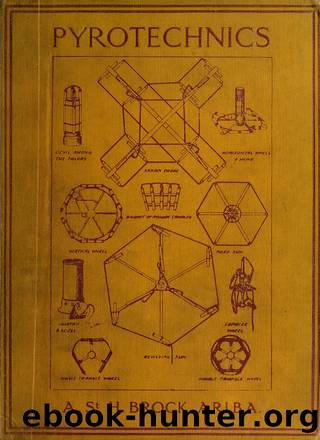Pyrotechnics: the history and art of firework making by Brock Alan St. H. (Alan St. Hill) 1886-

Author:Brock, Alan St. H. (Alan St. Hill), 1886-
Language: eng
Format: epub
Tags: Fireworks
Publisher: London, D. O'Connor
Published: 1922-04-15T00:00:00+00:00
97
PYROTECHNICS
the rocket with a clay diaphragm evidently suggested that the choking of the case might be dispensed with where the composition was less fierce, the necessary reduction of the orifice being produced by a clay diaphragm with a central hole of sufficient size. This method is followed with the gerb, fountains, and flower pot, and in the firework known to pyrotechnists as âfixtâ; this unit is largely used in display work to form the fringe frame or lattice effect of a set piece. â Fixt â are made in i oz. and 2 oz. sizes, and contain a composition of approximately one part of steel filings to four of mealed gunpowder and finish with a bounce. The origin of the name is uncertain: it may refer to their use on fixed pieces in contradistinction to one revolving, orâas is most probableâwas first used to distinguish between a fixed and a moving rocket.
The time of the introduction of the clay choke is uncertain. Jones, writing in 1765, although using clay in the heading of rockets, still choked all cases, but Mortimer (1824) uses it, although Ruggieri (1821), whilst doing the same, appears to think choking preferable.
The former gives instructions for charging the clay solid and boring the central hole ; Ruggieri, however, uses a nipple like a much shortened rocket spindle, in which he agrees with the modern practice. This method is also utilised at the present time for small-sized rockets.
Of the fireworks of the fountain class, probably the first to develop from the crude rocket form were the gerb and flower pot. The gerb, or Chinese tree, contains a composition of saltpetre, sulphur, charcoal and iron borings, with the additionâif more force is required, as for instance to turn a deviceâof mealed gunpowder. Early makers used mealed powder alone and â iron sand,â or cast-iron reduced to powder by hammering. This composition is known as Chinese fire, and, as its name implies, was introduced into Europe from the 98
SIMPLE FIREWORKSâROCKET CLASS
East. An interesting article appeared in the 14 Universal Magazine â of 1764, written by a Jesuit missionary on the subject of Chinese fireworks. In it he describes the making of iron sand as follows :
â Old broken or useless pots serve generally for making this sand ; they are broken into pieces of the breadth of the hand, after which, being made red-hot in the fire of a forge, they are thrown in that condition into a trough filled with fresh water, where they are left to cool. Thus calcined, the rust falls off in scales, and they are easily reduced into sand, being first broken into parcels of a fingerâs breadth. The anvil and hammer used for this purpose must be also of cast-iron, because steel flats the grains of sand. It is necessary that the angles of those grains should be sharp, as it is the angles that form the flowers.â
The word âgerbâ is derived from the French word meaning a sheaf of corn, and was first applied to water fountains.
Download
This site does not store any files on its server. We only index and link to content provided by other sites. Please contact the content providers to delete copyright contents if any and email us, we'll remove relevant links or contents immediately.
Contemporary Appliqué by Julia Triston(250)
Wild Wool & Colorful Cotton Quilts by Erica Kaprow(234)
Ultimate Applique Reference Tool by Annie Smith(215)
Organic Appliqué by Kathy Doughty(207)
Wool Appliqué Heirlooms by Mary A. Blythe(204)
Wool Appliqué the Piece O' Cake Way by Becky Goldsmith(190)
Kim Schaefer's Wool Appliqué Calendar Quilts by Kim Schaefer(186)
Festive Fall Quilts by Kim Schaefer(131)
Dresden Quilt Blocks Reimagined by Candyce Copp Grisham(129)
Exploring Folk Art with Wool Appliqué & More by Rebekah L. Smith(126)
Mataf and the wolves--Mataf et les loups by Jasmin Heymelaux(30)
Pyrotechnics by Unknown(22)
Chess Openings by Frank James Marshall(17)
Pyrotechnics: the history and art of firework making by Brock Alan St. H. (Alan St. Hill) 1886-(15)
Super Quiz Book for [email protected] Fans by Ricky Roogle(9)
A Brush With Murder by Donna Clancy(5)
